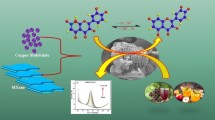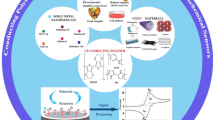Abstract
This paper reports the first ever use of carbonized pistachio nut shells (CPNS), as an electrode material for electrochemiluminescence (ECL) detection. The carbonization of pistachio nut shells was achieved at 500 °C for 2 h using chemical vapor deposition apparatus. Consequently, the CPNS were activated with KOH at 900 °C in Argon atmosphere. Field emission scanning electron microscopy coupled with energy dispersive X-ray spectroscopy confirmed the grain size, structural porosity, activation with KOH and elemental composition. The activated CPNS were used as working electrode in ECL study. Tris (2,2′-bipyridyl) ruthenium (II) (\( {\text{Ru(bpy)}}_{ 3}^{ 2+ } \)) was used as an ECL label. While still suffering from low reproducibility, the CPNS electrodes showed ECL efficiency and stability comparable to standard glassy carbon electrodes. The very low cost of the raw material, the intrinsic carbon biocompatibility, and their ecological sources in combination with such good results make them good candidates for future ECL-based disposable biosensor platforms.







Similar content being viewed by others
References
Li J, Guo S, Wang E (2012) Recent advances in new luminescent nanomaterials for electrochemiluminescence sensors. RSC Adv 2:3579–3586. doi:10.1039/C2RA01070D
Wilson R, Clavering C, Hutchinson A (2003) Paramagnetic bead based enzyme electrochemiluminescence immunoassay for TNT. J Electroanal Chem 557:109–118. doi:10.1016/S0022-0728(03)00353-X
Lin Z, Liu Y, Chen G (2008) TiO2/Naflon film based electrochemiluminescence for detection of dissolved oxygen. Electrochem Commun 10:1629–1632. doi:10.1016/j.elecom.2008.08.015
Wu B, Miao C, Yu L, Wang Z, Huang C, Jia N (2014) Sensitive electrochemiluminescence sensor based on ordered mesoporous carbon composite film for dopamine. Sens Actuat B 195:22–27. doi:10.1016/j.snb.2014.01.012
Ge L, Yan J, Song X, Yan M, Ge S, Yu J (2012) Three-dimensional paper-based electrochemiluminescence immunodevice for multiplexed measurement of biomarkers and point-of-care testing. Biomaterials 33:1024–1031. doi:10.1016/j.biomaterials.2011.10.065
Li J, Xu Y, Wei H, Huo T, Wang E (2007) Electrochemiluminescence sensor based on partial sulfonation of polystyrene with carbon nanotubes. Anal Chem 79:5439–5443. doi:10.1021/ac0706224
Sanginario A, Demarchi D, Civera P, Giorcelli M, Castellino M, Tagliaferro A (2010) Carbon nanotube electrodes for electrochemiluminescence biosensors. Proc Eng 5:1–4. doi:10.1016/j.proeng.2010.09.231
Jenkins GM, Kawamura K (1976) Polymeric carbons–carbon fibre, glass and char. Cambridge University Press, Cambridge
Kinoshita K (1988) Carbon: electrochemical and physicochemical properties. Wiley, New York
Apaydin-Varol E, Pütün E, Pütün AE (2007) Slow pyrolysis of pistachio shell. Fuel 86:1892–1899. doi:10.1016/j.fuel.2006.11.041
Kandiyoti R, Lazaridis JI, Dyrvold B, Weerasinghe CR (1984) Pyrolysis of a ZnCl2-impregnated coal in an inert atmosphere. Fuel 63:1583–1587. doi:10.1016/0016-2361(84)90231-X
Yang T, Lua AC (2003) Characteristics of activated carbons prepared from pistachio-nut shells by potassium hydroxide activation. Microporous Mesoporous Mater 63(1):113–124
Otowa T, Nojima Y, Miyazaki T (1997) Development of KOH activated high surface area carbon and its application to drinking water purification. Carbon 35(9):1315–1319
Noman M, Sanginario A, Jagdale P, Demarchi D, Tagliaferro A (2014) Pyrolysed bamboo electrode for electrogenerated chemiluminescence of \( {\text{Ru}}\left( {\text{bpy}} \right)_{3}^{2 + } \). Electrochimical Acta 133:169–173. doi:10.1016/j.electacta.2014.03.100
Sanginario A, Giorcelli M, Tagliaferro A, Demarchi D (2012) Improving the signal-to-noise ratio of an ECL-based sensor using ad hoc carbon nanotube electrodes. J Micromech Microeng 22:074010. doi:10.1088/0960-1317/22/7/074010
Leland JK, Powell MJ (1990) Electrogenerated chemiluminescence: an oxidative-reduction type ECL reaction sequence using tripropyl amine. J Electrochem Soc 137:3127–3131. doi:10.1149/1.2086171
Richter MM (2004) Electrochemiluminescence (ECL). Chem Rev 104:3003–3036. doi:10.1021/cr020373d
Rubinstein I, Bard AJ (1981) Electrogenerated chemiluminescence. 37. Aqueous ECL systems based on \( {\text{Ru}}( 2,2^{\prime}{\text{-bipyridine}})_{3}^{2 + } \) and oxalate or organic acids. J Am Chem Soc 103:512–516. doi:10.1021/ja00393a006
Yin X, Dong S, Wang E (2004) Analytical applications of the electrochemiluminescence of tris (2,2′-bipyridyl) ruthenium and its derivatives. TrAC 23:432–441. doi:10.1016/S0165-9936(04)00603-X
Yuan Y, Han S, Hu L, Parveen S, Xu G (2012) Coreactants of tris (2,2′-bipyridyl) ruthenium (II) electrogenerated chemiluminescence. Electrochim Acta 82:484–492. doi:10.1016/j.electacta.2012.03.156
Author information
Authors and Affiliations
Corresponding author
Rights and permissions
About this article
Cite this article
Noman, M., Sanginario, A., Jagadale, P. et al. Activated carbonized pistachio nut shells for electrochemiluminescence detection. J Appl Electrochem 45, 585–590 (2015). https://doi.org/10.1007/s10800-015-0813-4
Received:
Accepted:
Published:
Issue Date:
DOI: https://doi.org/10.1007/s10800-015-0813-4




